Introduction
The majority of people define e-commerce as the act of shopping through the World Wide Web (WWW). However, e-commerce includes various activities such as internal business processes and business-to-business transactions (Schneider 2011). E-commerce has been accessible ever since the 1980s. However, the mode of conducting e-commerce has evolved with the invention of Information Technology (IT) in the contemporary business world. During the 1980s, e-commerce was conducted through telephone, fax, telex, and telegram. Efforts to standardize the exchange of business information led to the development of Electronic Data Interchange [EDI].
The rate of ICT development has provided a unique opportunity for local and international businesses. Many local and international businesses are adapting to the modern method of conducting business, which employs the tenets of e-commerce. E-commerce has empowered consumer groups that were previously discriminated against. Women have been empowered by e-commerce through diverse aspects. Molenaar (2010) asserts, “In B2C e-commerce, most success stories of women-empowered enterprises have to do with marketing unique products to consumers with disposable income” (p.99). Change in consumer behavior has also played an essential role in the growth of e-commerce. Currently, the disposable income amongst women has increased significantly over the past few decades. Women are increasingly being absorbed into the job market. Consequently, their income has increased. Molenaar (2010) opines, “Women have caught up with men in the last ten years when it comes to online shopping” (p.66). In 1998, 90% of online shoppers were men. By the end of 2010, it is estimated that 51% of online shoppers were women. From 2000, the number of consumers shopping online has increased 40 times; moreover, consumer spending on online shopping has increased 700 times compared to the total retail trade (Molenaar 2010).
It is expected that the trend of online shopping will continue to grow. Online shopping provides consumers with a unique experience. For example, consumers are in a position to obtain effective product descriptions, compare prices, and order products more conveniently. Moreover, online shopping provides consumers with an opportunity to share their product experiences with friends and colleagues. Businesses are formulating different strategies aimed at exploiting emerging market trends and changes in consumer behavior.
The growth of ICT in Saudi Arabia has arisen from a number of factors. First, the Saudi government has formulated and implemented policies aimed at encouraging private and public organizations to incorporate e-commerce in their operational strategies. Its commitment towards e-commerce began in 2001 (AlGhamdi 2012). A study conducted in 2010 by EUI ranks Saudi Arabia 52nd with regard to e-readiness. Moreover, the high rate of Internet penetration in Saudi Arabia provides a unique opportunity for the growth of e-commerce. Available literature shows that the Internet penetration in Saudi Arabia increased from 5% [1 million in 2001] to 14% [11.2 million by 2011] (AlGhamdi et al. 2011).
Despite the government’s commitment to stimulating the growth of e-commerce, its rate of growth is relatively low. The government’s support towards e-commerce, which is essential in the growth of online shopping, is relatively low. It is estimated that only 9% of organizations in the Saudi Arabian manufacturing sector have integrated e-commerce. A survey conducted in 2011 shows that approximately 3.1 million Saudis have engaged themselves in online shopping at one point in their lives. AlGhamdi et al. (2011) further opine that online shopping in Saudi Arabia is underdeveloped due to the low credit card penetration and Internet usage. The likelihood of online shopping growing in Saudi Arabia is high due to the perceived benefits. Online shopping is associated with a certain degree of perceived enjoyment amongst female consumers in Saudi Arabia.
This paper aims at achieving the following objective.
-
- To conduct an in-depth analysis of the perspective and perception of Saudi Arabian women on online shopping
- The following research questions will be evaluated in this study.
-
- What are the perspectives of Saudi women in Jeddah and Riyadh on online shopping?
- What is the most prevalent online shopping behavior amongst young women from Jeddah and Riyadh?
Literature Review
The rate of Internet utilization varies from one country to another. It is estimated that online sales in the US increased with a margin of 120% from 1998 to 1999. Online shopping in the UK increased from 11 million consumers to 28 million by the end of 2006 (Almaghrabi & Dennis 2010). Online transactions in Saudi Arabia grew from $ 278 million to $556 million during the period ranging between 2002 and 2005. This aspect shows that the likelihood of growth with regard to online shopping is high.
One of the factors stimulating the growth of online purchasing in Saudi Arabia relates to the emergence of social media such as Facebook. Saudi Arabia has experienced a significant increment in the number of Internet users. It is estimated that the annual rate of growth with regard to Internet usage in Saudi Arabia is 33%. Despite this aspect, the rate of online shopping is relatively low. According to Almaghrabi and Dennis (2010), the low rate of online purchases can be explained by the Saudis’ attitude towards change. A significant proportion of Saudis are resistant to change.
According to Almaghrabi and Dennis (2010), online shopping intentions vary from one consumer to another. Moreover, their continuance with online shopping is influenced by the consumers’ experience. A study conducted by Al-Hudhaif and Alkubeyyer (2011) showed that women are interested in the new technologies related to online shopping because of the convenience and the satisfaction that they bring.
Al-Hudhaif and Alkubeyyer (2011) assert that different factors that influence the consumers’ online shopping decisions. A survey conducted by PayPal on the consumers’ attitude towards online shopping revealed that online shopping is influenced by the type of transaction, ease of use, payment choice, comfort level, level of trust, and level of satisfaction. These factors are also known as external or internal factors.
The decision to integrate a particular technology in the consumers’ decision-making process is influenced by the perceived ease of use. If consumers develop the perception that using a particular type of technology is difficult, their likelihood of integrating the technology is relatively low. By purchasing online, consumers intend to attain a hassle-free and fast shopping process. It is estimated that approximately 31% of consumers do not prefer providing their names, credit card information, and address on merchant websites. Thus, it is fundamental for online vendors to develop online shopping systems that remember the consumers’ information. This aspect will lead to the development of a sense of satisfaction and ease in the consumers’ shopping process.
Perceived risk has a significant influence on the consumers’ decision regarding online shopping (AlMowalad & Putit 2013). Consumers also analyze the perceived degree of risk associated with online shopping. Some consumers are of the opinion that providing their credit card information over the Internet is unsafe. Consumers have the perception that providing vendors with confidential information exposes them to various threats such as hacking. A study conducted by Forrester Research in 2006 shows that approximately 37% of consumers who purchase online are concerned about identity theft. This group stopped engaging in online purchasing leading to a loss of $40 billion with regard to online sales. Thus, the protection of the consumers’ confidential information plays a vital role in determining online consumer preferences. Moreover, the consumers’ confidence towards online vendors influences their decision with regard to where to purchase (AlMowalad & Putit 2013).
Other perceived risks associated with online shopping include psychological and social loss. Visiting shopping malls makes consumers develop a unique experience. Consumers are also of the opinion that the online vendors may not be bear the responsibility if the product does not reach them. Thus, the loss that might occur in the delivery process is borne by the customer (AlMowalad & Putit 2013).
The extent to which consumers trust online vendors influences their perception of online shopping. Some consumers are of the opinion that online companies do not uphold high standards hence affecting their decision to adopt online shopping. Almaghrabi and Dennis (2010) assert that a high level of trust and confidence is paramount in online shopping, as the transactions conducted online are non-face-to-face. Consumers may develop a feeling that they will be cheated throughout the entire transaction. The level of trust developed between the consumer and the vendor determines the customers’ online purchase repeat behavior formed.
According to Guo (2011), online shopping in Saudi Arabia is influenced by various internal factors. The internal factors relate to the consumers’ demographic factors such as level of education, age, gender, income level, and online experience. The generation gap has a significant impact on the consumers’ perception of online shopping. Online shopping is common amongst consumers aged between 18-34 years. The older generation of customers is less likely to purchase online. The difference in online purchase behavior between the two age groups emanates from the fact that younger consumers are more inclined to use different mobile devices compared to the older generation.
Previous studies show that gender has a significant influence on consumers’ online shopping decisions. According to Almaghrabi and Dennis (2010), the likelihood of online shopping amongst women is relatively high compared to men fro women adopt a specific technology in their purchasing process more easily if they understand its ease of use. On the other hand, men are more concerned about the technology’s usefulness. Almaghrabi and Dennis (2010) further opine that women form a key component in households’ purchase decisions. Moreover, women are more likely to derive satisfaction by shopping online compared to men.
The consumers’ level of education also influences their perspective towards online shopping as the level of education predicts the likelihood of Internet usage amongst consumers. Various scholars associate the consumers’ level of education with Internet usage and hence online shopping.
Consumers who earn higher income are more likely to shop online compared to consumers within the low-income group. Punj (2012) asserts, “Higher-income consumers value their time more because of its opportunity cost” (p. 636). High-income earners conduct a cost-benefit analysis on the amount of time spent online and benefits gained.
Some of the most common external factors that limit the adoption of online shopping related to product quality and prices, reliability of trading, and network infrastructure. According to Guo (2011), consumers are concerned about the reliability of the online shopping network. Security of the online shopping software is one of the elements that consumers evaluate, which is motivated by the need to maintain their privacy and security of personal information. Consumers are also concerned with the reliability of the online purchasing process. In a bid to achieve this goal, e-retailers must enhance timeliness and efficiency with regard to distribution logistics. Moreover, e-retailers must ensure that the online shopping process is cost-effective.
Saudi Arabia does not have an effective ICT infrastructure. One of the major limitations in the country is the poor mailing system. The country does not have an effective postal address system. For example, there are no well-defined street addresses to enhance the delivery of products to the customers’ homes. Moreover, most Saudis in rural areas have not adopted the postal delivery system.
Adoption of e-commerce Saudis is also hindered by the fact that the country does not have well-developed online stores. Guo (2011) asserts that only a few online stores that target Middle East consumers have been established. Examples of such online stores include e-mall.com.sa and Souq.com. Despite this aspect, most of the platforms are not well developed. Thus, most online purchases in Saudi Arabia are undertaken through international online stores. The international online stores provide shoppers with fair product prices in addition to enabling them to perform online transactions using the currency of their choice. Moreover, the platforms provide consumers with competitive international shipping costs (Guo 2011).
Methodology
The study will make use of both qualitative and quantitative research methods in order to gain deeper insight and a greater understanding of the thoughts and reactions of Saudi women regarding online shopping. The research design enables the researcher to be logical. Consequently, the reliability of the study findings is improved.
Quantitative research methods entail integrating numbers that can be used to analyze the findings of the study statistically. Thus, the researcher is in a position to establish the cause-and-effect relationships. On the other hand, qualitative research entails studying the subject under investigation. Thus, the researcher is can describe ongoing processes. The two research designs are characterized by varying strengths and weaknesses. One of the major strengths of qualitative research is that the researcher gains substantial information due to the questions asked. Moreover, the qualitative research design is very cost-effective. The researcher does not have to undertake an extensive survey in order to reach a conclusion. However, samples of the target population are evaluated to represent the entire target population. One of the major weaknesses of qualitative research methods is that assumptions are made to represent the target population.
The strength of the quantitative research method arises from the fact that it is supported by statistics. Thus, the researcher can provide a wide range of information. Thus, quantitative research enables the researcher to increase the scope of the study. Moreover, it is possible to represent quantitative data using graphs and charts.
This study intends to examine the level of awareness, level of trust with regard to online payment, and the level of interest amongst consumers towards online shopping. The target population in this study relates to women aged between 18-30 years in Saudi Arabia. Previous studies show that women in Saudi Arabia are embracing online shopping. As indicated in the literature section, a number of factors are attributed to the growth of online shopping in the country. These factors relate to internal and external factors.
The external factors relate to product quality and prices, reliability of trading, and network infrastructure. On the other hand, the internal factors relate to the consumers’ demographic factors such as level of education, age, gender, income level, and online experience Random-sampling technique was used in selecting the study sample. One hundred and nineteen respondents were selected from the target population.
To attain the aforementioned objective, the researcher relies on primary sources of data. Data were collected using two main data collection instruments, which include interviews and surveys. The researchers designed a questionnaire that was used in the process of conducting the survey. The questionnaires were open-ended in nature. Thus, the researcher managed to collect sufficient data from the respondents. The questionnaires were distributed to the respondents electronically using social media such as Facebook. Through in-depth interviews and surveys, the researcher intends to examine the level of awareness, level of trust in terms of online payment, and most importantly the level of interest in online shopping. The researcher obtained 119 responses through interviews and surveys.
In an effort to improve the quality of the study, the research questions were evaluated individually. The qualitative research design enabled the researcher to collect voluminous data. Graphs and tables were used in the process of presenting the data collected. Thus, the researcher was in a position to condense the data collected.
In the process of conducting the study, a number of limitations were experienced.
First, I am not based in Saudi Arabia, which made it difficult to find respondents. Moreover, some respondents did not understand all the questions. Thus, they were left unanswered.
Findings
The study entails a survey of online shopping behavior amongst women aged between 18-30 years in Jeddah and Riyadh. One hundred and nineteen responses were obtained. Over ninety-eight percent of the respondents interviewed were aged between 18-30 years. Only 1.71% of the respondents did not fit in this category. The age group of the respondents interviewed varied as illustrated by the graph below.
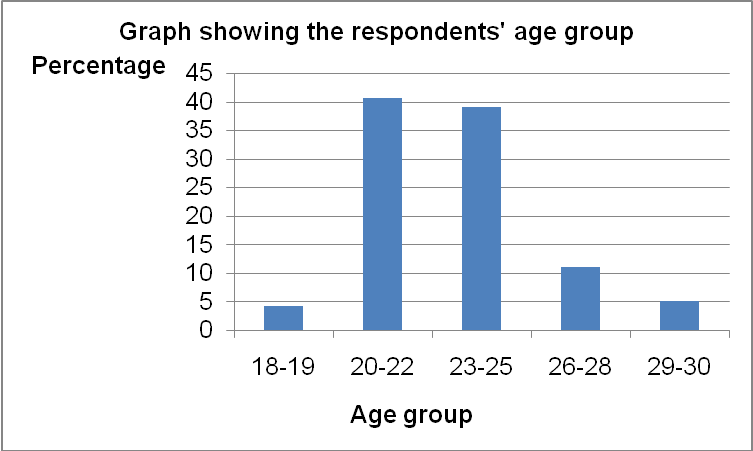
In an effort to obtain a general view of the perception of online shopping behavior amongst women in Saudi Arabia, the researcher focused on women from Jeddah and Riyadh. Eighty-four percent of the respondents were from Jeddah while 15.25% were from Riyadh.

The respondents interviewed had different educational qualifications as illustrated below.
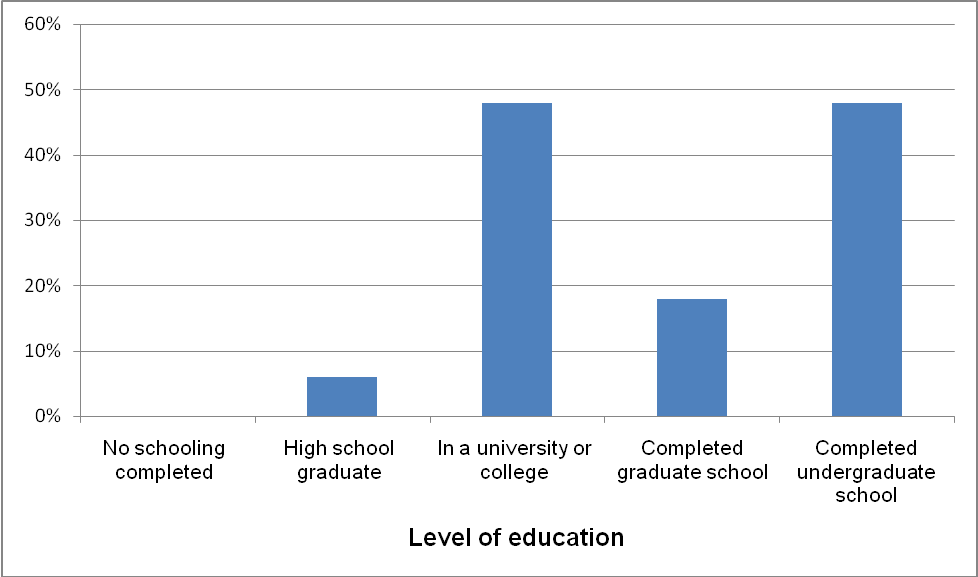
The researcher conducted three interviews on Saudi women in an effort to understand their perspective and behavior regarding online shopping. Two of the women were from Jeddah while one of them was from Riyadh. Despite the fact that the three women enjoyed shopping online, they had a varied perspective on online shopping. One of the respondents had issues with online shopping because it does not provide the customer with an opportunity to feel or try the product before purchasing. As a result, the customer is forced to return the product to the seller. The respondents also cited the poor development of online shopping stores in Saudi Arabia to be a major factor that makes them hesitant to shop online. However, ASOS, Netaporter, and Shopbop were cited as the best local online shopping store and Amazon as the best international online store. These online stores offer diverse products, good pricing, effective customer service, return policies, and effective shipping strategies. All the women are comfortable with providing their credit card information online.
On the other hand, two of the women cited time and efficiency as the main factors that motivate them to shop online. In their opinion, shopping online is not time-consuming. Products are delivered to the customers’ doorstep. Moreover, customers are in a position to purchase different products through one website. The respondents’ responses with regard to the frequency of purchasing online varied. Some respondents purchase online frequently such as weekly, monthly, and yearly.
The women cited clothes as the main products that they purchase online. The respondents cited satisfaction, security, time, and ease of use as the major factors that they incorporate when deciding to shop online. On the flip side, the respondents cited loss of socialization as a major hindrance in their online shopping. From their personal experience, the respondents said that they would encourage fellow women in Saudi Arabia to shop online. The respondents described online shopping in Saudi Arabia as uncharted waters that retailers should seek to exploit. Security of the payment is one of the major issues that Saudi women are concerned with, but the respondents are of the opinion that there are no major problems associated with online shopping in Saudi Arabia. The interviews show that Saudi women like shopping. However, the culture is Saudi can be described as conservative. Consequently, most Saudis have not incorporated online shopping into their consumption processes.
In an effort to develop a statistical understanding of the perception of Saudi women on online shopping, quantitative research was conducted. The findings of the study are illustrated herein. The study showed that a considerable number of the respondents interviewed have purchased goods online. Approximately 92.44% of the respondents interviewed said that they have purchased various products online at one point in their lives as illustrated by the chart below.
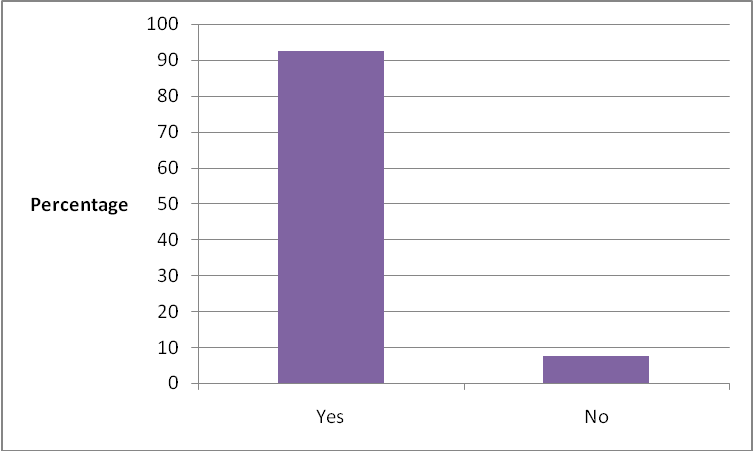
The study shows that women in Saudi Arabia have varying perception regarding online shopping as illustrated by the frequency of purchases undertaken by the respondents. The chart below illustrates the respondents’ responses with regard to how they shop online.
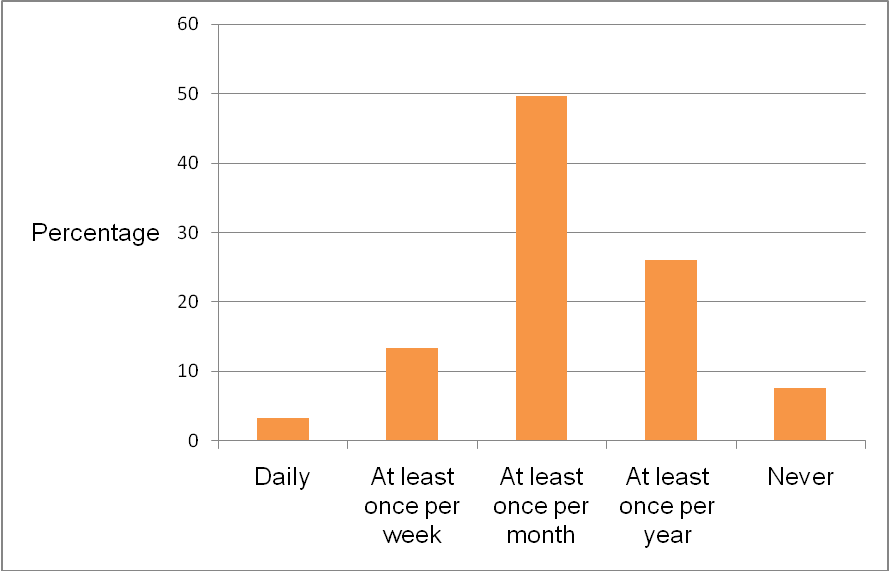
The respondents’ opinion with regard to the type of product purchased online varied. However, most of the respondents cited fashion and accessories are the main products that they purchase online. The chart below illustrates the respondents’ responses with regard to products purchased online.
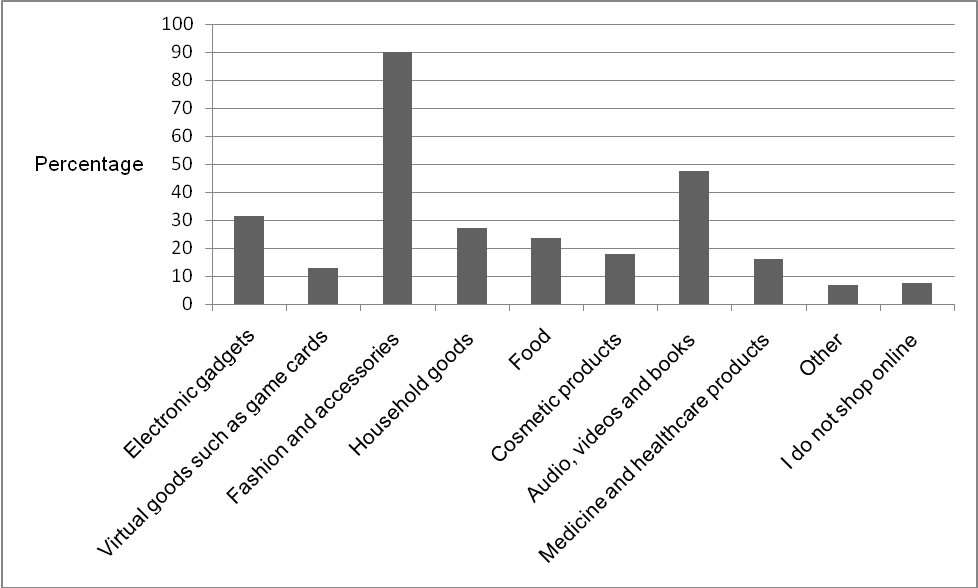
When asked to outline the reasons that de-motivate them to purchase online, the respondents cited a number of reasons. Some of the main reasons cited include product quality, security, and lack of knowledge on how to shop online coupled with the complication associated with online shopping. The chart below illustrates the respondents’ responses.
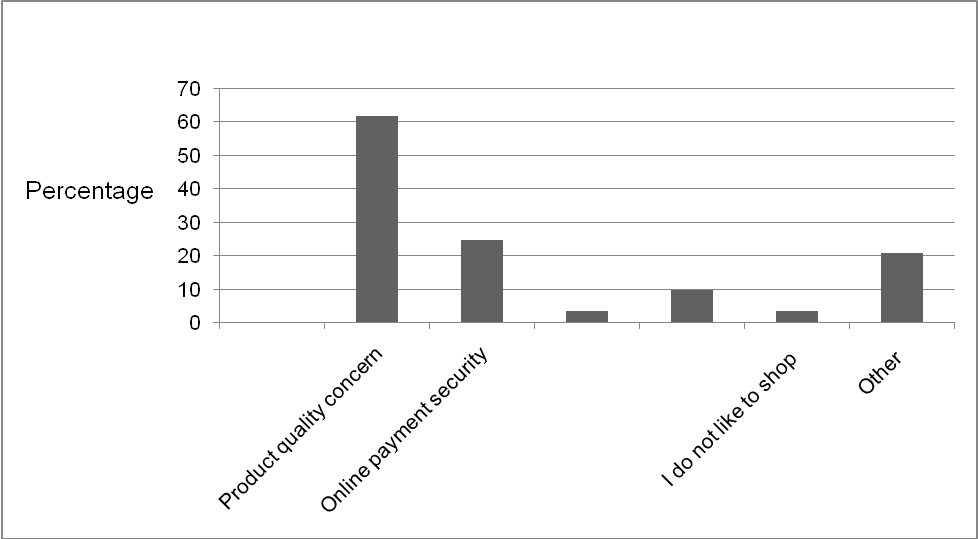
The respondents cited different factors that encourage them to shop online. Some of these responses are outlined in the chart below.
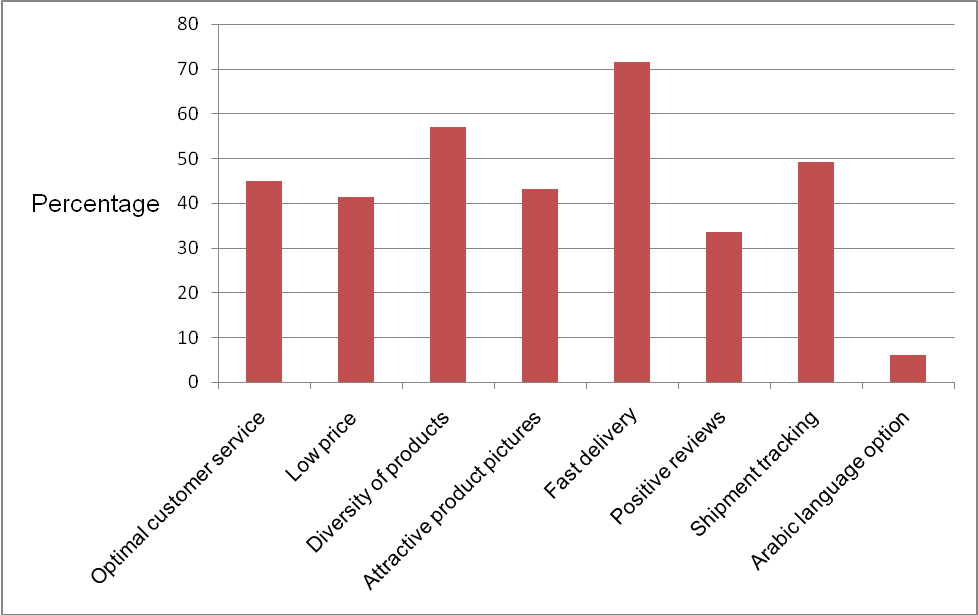
The respondents have varied opinions regarding online shopping. Some of the reasons cited relate to the complexity of the online shopping process, the customers’ preference towards online and conventional shopping, better price offers, product diversity, product delivery, and ease of using the online shopping platforms. The chart below illustrates the respondents’ opinions regarding the above issues.
Moreover, the respondents cited different factors that motivate them to purchase online. Some of the main reasons include the amount of time consumed during the shopping process, delivery of products to the customers’ homes, confidence with regard to giving credit card information, better selection of products through the website, and appealing return policies. The respondents’ responses are illustrated in the table below.
Analysis
In regards to my research paper, understanding the factors that affect the adoption of e-commerce in Saudi Arabia is highly important. The paper points out to relevant evidence and past research on how internal and external factors influence the buying behavior amongst women in Saudi Arabia. The article has provided an in-depth understanding of online shopping by analyzing the growth of e-commerce in Saudi Arabia. Alotaibi (2013) supports the views of other scholars by claiming that the introduction of the Internet has played a critical role in the growth of online shopping in the country.
The research shows that Saudi women have varied perspectives with regard to online shopping as illustrated by the frequency of such shopping. Some women in Saudi shop online frequently compared to others. The shopping frequency varies weekly, monthly, and yearly. The respondents cited a number of factors that influence their online shopping decisions. Some of the factors cited relate to the convenience of shopping products online. The respondents assert that online stores provide customers with an opportunity to shop for different products from one point. Moreover, Saudi women are confident with regard to online shopping. Thus, they are not worried with regard to providing their credit card information online. The study also shows that women in Saudi Arabia prefer shopping online due to the capability to track the shipment during the delivery process. The complexity of the online shopping systems is also cited as a major fact that influences online shopping amongst Saudi women. Most Saudi women aged between 18 and 30 years are conversant with the English language, which is the main language used in online shopping platforms such as Amazon. Thus, they are in a position to navigate through various online shopping stores. In their opinion, the online shopping platforms in the country are not complicated.
From the research, it is evident that online shopping provides women with a new and unique experience as the processes of product ordering, viewing, and delivering are very different from the conventional shopping process. Consequently, most women in Saudi are likely to adopt online shopping. Despite the Saudi government’s commitment to developing ICT in the country, e-commerce in Saudi Arabia is still underdeveloped. However, this trend is expected to change in the future (Alotaibi 2013). Consequently, the potential of growth in online shopping amongst Saudi women is high.
One of the factors that will enhance the growth of e-commerce relates to the increment in the number of consumers using the internet in their consumption processes (Almousa 2013). Over the past few years, Saudi Arabia has experienced an increment in the number rate and extent of internet connectivity. Thus, the likelihood of customers shifting from traditional purchasing systems to new systems such as online shopping is high. Thus, the country will experience an increment in the number of online stores. Currently, most online purchases in Saudi are conducted on international online stores (Sait et al. 2004). Some of the local online stores include Netaporter and Shopbop. According to the respondents, the attractiveness of online shopping websites influences the consumers’ decision to shop online.
The study confirms the fact that online purchasing behavior amongst Saudi women is subject to a number of factors as evidenced by the literature review. Most of these factors relate to internal and external factors. From the survey, it is evident that online purchase behavior is influenced by age and educational level. Online purchasing behavior is prevalent amongst college and university graduates. The relationship between educational level and online shopping is well explained by the fact that the customer has to understand the terms and conditions that are associated with online shopping.
The type and quality of products also influence online purchase behavior amongst Saudi women. Some of the products that are commonly shopped online include books, audio, and video products, and fashion and accessories. The security of the online payment system also influences the consumer’s purchase decision, which is in line with findings of a study conducted by Guo (2011) who asserts that consumers are concerned about the reliability of the online shopping network. With regard to reliability, consumers are concerned with fast product delivery. The study shows that most women in Saudi Arabia do not consider online shopping to be complicated. Moreover, online shopping enables consumers to save time. This aspect explains why online shopping is increasingly becoming common amongst Saudi women (Taylor & Owusu 2012). From the above analysis, the potential for growth with regard to online shopping amongst Saudi women is very high.
Conclusion
Online shopping amongst women in Saudi Arabia is not well developed despite the fact that the country is characterized by an effective ICT infrastructure. This aspect presents a perfect business opportunity for retailers to exploit and in a bid to exploit the market opportunity successfully, it is imperative for retailers to understand the consumers’ perspective on online shopping. Some of the factors that e-retailers should take into account relate to the customers’ level of trust, ease of using the online shopping software, payment choice, comfort level, level of trust, and level of satisfaction. Moreover, e-retailers should also understand the target customers’ gender, level of education, and age before implementing their online shopping systems as consumers’ online shopping behavior is influenced by their demographic characteristics.
From the study, it is imperative for retailers in Saudi Arabia to adopt online trading in order to maximize their profitability. The change in consumer behavior with regard to online shopping especially amongst women presents a unique opportunity for retailers to exploit. Traditionally, women in Saudi Arabia were ranked amongst the minority groups. However, women are increasingly being integrated into the job market. Thus, their income has increased significantly. Moreover, their level of education has improved significantly over the years. Therefore, the likelihood of growth with regard to online shopping amongst women is high.
The country’s development with regard to ICT infrastructure also presents a perfect opportunity for the growth of e-commerce. Thus, a large number of consumers in Saudi Arabia are using the Internet. However, the retailers should ensure that they establish effective online stores. The online stores should ensure that the customers’ payment information is not compromised. Moreover, the online stores should provide customers with a wide range of products for selection. This move will lead to the development of a high level of customer loyalty hence nurturing repeat purchase behavior amongst customers.
In a bid to promote the growth of online shopping behavior amongst Saudi women, it is imperative for firms that have adopted the concept of online shopping and the government to take into account the following. Both the government and retailers should improve the country’s communication system and ensure that effective security software is integrated. This aspect will play a critical role in influencing the customers’ perception regarding the privacy and security of their payment information through the online payment system. Thus, the risk of purchasing online will be reduced significantly. In addition, online retailers should ensure that their online shopping platforms provide customers with competitive prices and high quality products. Finally, businesses should integrate a seamless distribution system by ensuring the timeliness and efficiency of the distribution system.
Reference List
Al-Hudhaif, S & Alkubeyyer, A 2011, ‘E-Commerce Adoption Factors in Saudi Arabia’, International Journal of Business & Management, vol. 6 no. 9, pp. 122-133.
AlGhamdi, R 2012, ‘Factors influencing E-commerce adoption by retailers in Saudi Arabia: a quantitative analysis’, International Journal of Electronic Commerce Studies, vol. 3 no. 1, pp. 83-100.
AlGhamdi, R, Nguyen, A, Nguyen, J & Drew, S 2011, Factors influencing Saudi customers decision to purchase from online retailers in Saudi Arabia: A quantitative analysis, Griffith University, New York.
Almaghrabi, T & Dennis, C 2010, ‘Driving online shopping: Spending and behavioral differences among women in Saudi Arabia’, International Journal of Business Science & Applied Management, vol. 5 no. 1, pp. 30-47.
Almousa, M 2013, Barriers to e-commerce adoption: Consumers’ perspective from a perspective from a developing country, Scientific Research, New York.
AlMowalad, A & Putit, L 2013, ‘Factors influencing Saudi Arabian women’s shopping behavior in online purchase activities’, Journal of Emerging Economies and Islamic Research, vol. 1 no. 2, pp. 1-13.
Alotaibi, M 2013, ‘E-Commerce Adoption in Saudi Arabia: an Assessment of International, Regional and Domestic Web Presence’, International Journal of Information Technology and Computer Science, vol. 2 no. 3, pp. 42-56.
Guo, L 2011, ‘A research on influencing factors of consumer purchasing behaviors in cyberspace’, International Journal of Marketing Studies, vol. 3 no.1, pp. 182-189.
Molenaar, C 2010, Shopping 3.0: Shopping, the Internet or both, Ashgate Publishers, Burlington.
Punj, G 2012, ‘Income effects on relative importance of two online purchase goals: Saving time versus saving money,’ Journal of Business Research, vol. 65 no.5, pp. 634-640.
Sait, S, Al-Tawil, K & Ali, S 2004, ‘E-Commerce in Saudi Arabia: Adoption and perspectives’, Australasian Journal of Information Systems, vol. 12 no. 1, pp. 54-74.
Schneider, G 2011, Electronic commerce, Cengage Learning, Boston.
Taylor, T & Owusu, E 2012, ‘Factors affecting Internet and e-commerce adoption among small and medium sized enterprises non-traditional exporters: Case studies of Ghanaian handicraft exporters’, European Journal of Business and Management, vol. 4 no. 13, pp. 25-40.